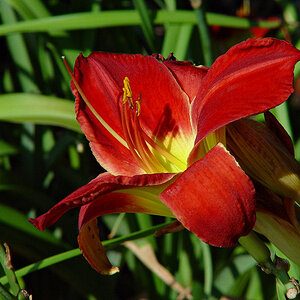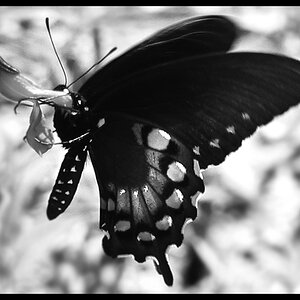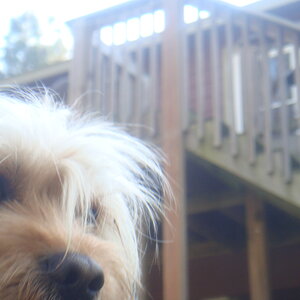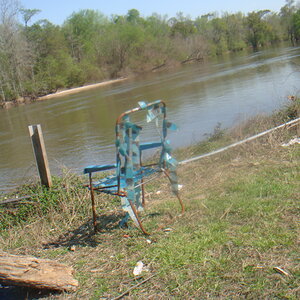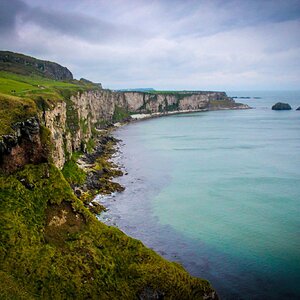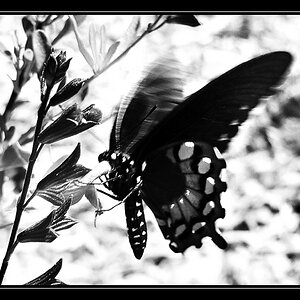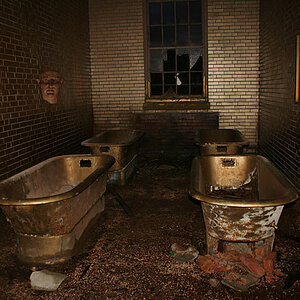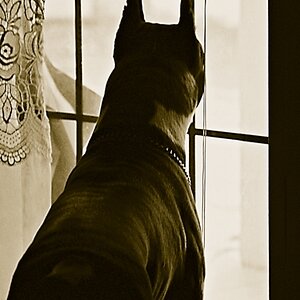- Joined
- Mar 8, 2011
- Messages
- 25,157
- Reaction score
- 9,010
- Location
- Iowa
- Website
- pixels.com
- Can others edit my Photos
- Photos NOT OK to edit
I decided to take an otherwise dreary, cold and cloudy day and do something constructive. So I set up a porcelain rabbit on a table, aimed a light at it, and set up my D7000 tethered to my old computer (about 7 years old, running W-XP) to do some tests of various tethering options.
I decided to write a bit about 4 programs that are available on-line. They are either freeware, shareware, or low-cost options of Nikons ControlPro software. I found the following: DIYPhotoBits, DCamCapture, SMTether and Remote Control for Nikon.
DIYPhotoBits Camera Control 5.1
DIYPhotoBits was one of the first freeware programs I tried. I found it rather intuitive to use, and didnt need much hard thinking on my part.

I merely tried to click Shutter Release, which did just that, but no image was downloaded. The only problem I encountered is the fact that I needed to click on the Start tether button in the bottom right.
Once I did that, I clicked on Shutter Release again, and it took about 1.5-2 seconds for the image to appear on the screen.
I then realized that the images that show up are not being saved on the computer. So I clicked on the Select Folder button, and instructed the program to save the images where I wanted them to go.
Once those two simple items are set, youre pretty much ready to go.

The CONTROLS area is self-explanatory. You can alter the shutter speed, aperture, IOS, Exposure compensation and the white balance.
Once you figure out how to simply release the shutter, its time to scroll down and find a couple more features. One is a Time Lapse, which will take a series of images at intervals you set up. I tried a quick 5 shots, 3 seconds apart. The program did just that. I also set up a timed delay before the first image is taken, and the software performed as expected.
The other option is Bracketing, and allows you to set a number of shots taken, as well as how many stops each bracket should be. Checking the Enable Bracketing box starts the process, and you just have to click on Shutter Release again and your images will be automatically taken.
I tried a very common bracket: 3 shots, for a -2/0/+2 set. It appears the software is written so it takes the +2, then the -2, then the 0 EVs in that order.

As the images are taken, a list of the filenames are added to the left of the most recently taken image. You can click on any file, and the program will show that image in the Preview area.
Clicking on the Mark button simply renames the file to add a hyphen to the beginning of it. So image D7K_2795 becomes D7K_2795. Clicking Unmark reverses that process.
Clicking on the Post Process button gave me an An error has occurred in the script on this page message, so I cant give any more information on what that would be. My guess is its to export the selected image into some other post-processing software.
Choosing the Full Screen Preview button opens another window with the selected image sized to the screen. You can move this image around if you like, or just close it. I figured out what to do when you close the full-screen image and found the preview had disappeared . Just click Full Screen Preview again, and the small preview reappears.
Push external viewer to display latest image causes the next shutter actuation to perform the above automatically.
Being a raw shooter, I was happy to see DIYPhotoBits has the ability to take, preview and/or record .NEF images by switching from JPG to Raw. However, trying this gave me yet another An error has occurred in the script on this page message. Clicking on the Help button next to the option box took me to the DIYPhotoBits website, where I found instructions on how to use this feature. However, I was unable to get the software to even take a photo if raw was selected either on-screen or with the camera.
It was, to say the least, a disappointment that I couldnt take any .NEF images. However, maybe a patch or upgrade in the future will solve this problem.
One thing I liked is the ability to read the battery condition . Showing 80% for this test.
On a scale of 1-10, Id give DIYPhotoBits a 9.
Next up: DCamCapture.
The main screen of DCamCapture is quite a bit different. Some of the features are more intuitive, while others are more cryptic.
The Capture Folder is one that is obvious . Its simply asking where you want your images to go. Below it is a file naming option, which can be very handy. Instead of using the cameras file naming scheme, you can create your own. So for this demo, Ill use DCamCapture. The software will then sequentially number the images automatically.

Since the camera was set to take raw images, I noticed my filename selection ended with .nef. Could it be? It can take raw images? Using the red button at the top left (Capture), I clicked and hoped. After 3 seconds, no image appeared on the screen.
But I did have a raw images recorded on the computer! Perhaps if I changed the camera to RAW+JPEG .. click the red button .Still no on-screen preview, but both the .nef and .jpegs are recorded. Sadly, I could not get any images to show up on-screen. No on-screen or on-line help is accessible from the program. Perhaps its because the D7000 is so new, and the designer hasnt had a change to add it to the supported cameras.
Whats missing? Well, a whole lot of stuff. Since I couldnt preview any images, that really soured my on it. The ability to change basic camera settings such as shutter speed, aperture and ISO for one. Unless youre shooting where the lighting just does not and will not change, this is a huge drawback. Especially if the camera isnt easy to access just to change something. In a studio, this probably wont be much of a hindrance. But it may be a deal-breaker for many serious shooters.
The inability to change anything on the camera is a real downer. Cant change image size, file type, white balance .. nothing.
The red button with AF next to the Capture button activates the cameras AutoFocus. While it may be handy for some, I didnt find it very useful. Clicking on the next icon over, what appears to be reminiscent of old reel-to-reel audio recorders, is the ability to start recording movies. Since I didnt purchase my D7000 for its movie option, Ill leave that ability to others.

On the plus side, DCamCapture is the only one I tested that allows you to access LiveView and record movies from the PC. By clicking on the little monitor icon, you activate the D7000s LiveView function, and the view shown on the cameras monitor also appears on the PC screen. The preview screen also shows a grid of 12 horizontal and 19 vertical lines. Whether or not that is useful depends on the user.
DCamCapture does have a timer function, although it appears to be somewhat limited. For instance, it wont allow images to be taken less than 5 seconds apart. I tried the option, and the camera only took one image. Sadly, this function fails as well.
On my completely unofficial ranking system, DCamCapture gets a measly 1. In reality, the only difference between it and a wired/wireless (Nikons MC-DC2/ML-L3 or 3rd-party equivalent) remote is that the images are saved on the computer as well. And given the fact that the D7000 can utilize a second SD card to automatically back up images makes the failure of DCamCapture even sadder.
Next up: SMTether.
In order to initiate communication with the camera, you need to click on the Search button in the top left. Once thats done, youll need to tell the software where to save your images. Thats done with the Settings/Set Path option.

In order to take an image, just click on the Take button on the left. In less than 3 seconds, the image shows up in the preview area, as well as some of the metadata on the lower left.
SMTether allows changing of the white balance, shutter speed, aperture and ISO in various boxes. The changes are made using the Arrow Up and Arrow Down keys on your keyboard, not selected from a drop-down box with a list.

One oddity of the program is the file naming, which is automatic. Images filenames are IMGxxx.jpg. The xxx is the image number, increased sequentially automatically, and the first image is, strangely, IMG0, not IMG1. This is simply a quirk, not a defect.
SMTether does not support raw images, even if selected at the camera. Even selecting RAWs at the camera, none are recorded on either SD card.
Id give SMTether a 7.
Last on the Hit Parade: ColorRivers Remote Control for Nikon ($20).
I purchased this software last fall, before the D7000 was officially released. Unfortunately, it does not even recognize the D7000 at all.

I originally purchased it for controlling my D60, so my review here is using it instead of the D7000. Remote Control for Nikon appears to do the most of any of the software Ive tried. You can change ISO, shutter speed, aperture, ISO, Image quality, Image size, Active-D lighting, Noise Reduction, set the flash to TTL & manual as well as set the EV of it, change the release mode, even set the AF-area Mode. Off the cuff, Id say if you can set it using the buttons on the back of the camera, you can set it using the program.

As shown below, you can even fine-tune the white balance just like you can in-camera.

When I first tried this software late last year, I couldnt get the images to download. I kept getting an error message, and ColorRiver didnt seem interested to find out what the problem was. Since last fall, I have purchased a new computer, and for some reason (after I cleaned up a bunch of stuff off the old computer), the software now works as expected. It still, however, does not download using my old laptop. So theres obviously something on it that my old desktop does not have that is the problem.
What makes me happy about this software is the fact it fully supports .NEFs. Not only does it record them, but it also shows them in the preview area. So if you want to shoot just raws, you can at least see what is recorded.
Another great feature: You can zoom into an image with a -/+ slider. This allows you to really see details in the taken image, especially focus!

Since this software seems to be functioning for me now, Ill happily give it a 10! Even though its not freeware, for twenty bucks, you cant beat it! Perhaps support for the D7000 will be added to future editions of this fine program.
Although Im sure others will have different experiences with these programs, these reviews are strictly based on my own personal experience. What may not have worked for me may work fine for you, and vise-versa.
If you are somehow involved with any of these programs, and feel I have not provided an accurate picture (pun intended!) of it, feel free to clarify it here. Im not out to say one program is better than any other my 1-10 rating scale is based solely on my experience and my needs.
So if you're even mildly interested in shooting tethered with a D7000, here's three free and one low-cost option for you to try out!
Happy shooting!
.
I decided to write a bit about 4 programs that are available on-line. They are either freeware, shareware, or low-cost options of Nikons ControlPro software. I found the following: DIYPhotoBits, DCamCapture, SMTether and Remote Control for Nikon.
DIYPhotoBits Camera Control 5.1
DIYPhotoBits was one of the first freeware programs I tried. I found it rather intuitive to use, and didnt need much hard thinking on my part.

I merely tried to click Shutter Release, which did just that, but no image was downloaded. The only problem I encountered is the fact that I needed to click on the Start tether button in the bottom right.
Once I did that, I clicked on Shutter Release again, and it took about 1.5-2 seconds for the image to appear on the screen.
I then realized that the images that show up are not being saved on the computer. So I clicked on the Select Folder button, and instructed the program to save the images where I wanted them to go.
Once those two simple items are set, youre pretty much ready to go.

The CONTROLS area is self-explanatory. You can alter the shutter speed, aperture, IOS, Exposure compensation and the white balance.
Once you figure out how to simply release the shutter, its time to scroll down and find a couple more features. One is a Time Lapse, which will take a series of images at intervals you set up. I tried a quick 5 shots, 3 seconds apart. The program did just that. I also set up a timed delay before the first image is taken, and the software performed as expected.
The other option is Bracketing, and allows you to set a number of shots taken, as well as how many stops each bracket should be. Checking the Enable Bracketing box starts the process, and you just have to click on Shutter Release again and your images will be automatically taken.
I tried a very common bracket: 3 shots, for a -2/0/+2 set. It appears the software is written so it takes the +2, then the -2, then the 0 EVs in that order.

As the images are taken, a list of the filenames are added to the left of the most recently taken image. You can click on any file, and the program will show that image in the Preview area.
Clicking on the Mark button simply renames the file to add a hyphen to the beginning of it. So image D7K_2795 becomes D7K_2795. Clicking Unmark reverses that process.
Clicking on the Post Process button gave me an An error has occurred in the script on this page message, so I cant give any more information on what that would be. My guess is its to export the selected image into some other post-processing software.
Choosing the Full Screen Preview button opens another window with the selected image sized to the screen. You can move this image around if you like, or just close it. I figured out what to do when you close the full-screen image and found the preview had disappeared . Just click Full Screen Preview again, and the small preview reappears.
Push external viewer to display latest image causes the next shutter actuation to perform the above automatically.
Being a raw shooter, I was happy to see DIYPhotoBits has the ability to take, preview and/or record .NEF images by switching from JPG to Raw. However, trying this gave me yet another An error has occurred in the script on this page message. Clicking on the Help button next to the option box took me to the DIYPhotoBits website, where I found instructions on how to use this feature. However, I was unable to get the software to even take a photo if raw was selected either on-screen or with the camera.
It was, to say the least, a disappointment that I couldnt take any .NEF images. However, maybe a patch or upgrade in the future will solve this problem.
One thing I liked is the ability to read the battery condition . Showing 80% for this test.
On a scale of 1-10, Id give DIYPhotoBits a 9.
Next up: DCamCapture.
The main screen of DCamCapture is quite a bit different. Some of the features are more intuitive, while others are more cryptic.
The Capture Folder is one that is obvious . Its simply asking where you want your images to go. Below it is a file naming option, which can be very handy. Instead of using the cameras file naming scheme, you can create your own. So for this demo, Ill use DCamCapture. The software will then sequentially number the images automatically.

Since the camera was set to take raw images, I noticed my filename selection ended with .nef. Could it be? It can take raw images? Using the red button at the top left (Capture), I clicked and hoped. After 3 seconds, no image appeared on the screen.
But I did have a raw images recorded on the computer! Perhaps if I changed the camera to RAW+JPEG .. click the red button .Still no on-screen preview, but both the .nef and .jpegs are recorded. Sadly, I could not get any images to show up on-screen. No on-screen or on-line help is accessible from the program. Perhaps its because the D7000 is so new, and the designer hasnt had a change to add it to the supported cameras.
Whats missing? Well, a whole lot of stuff. Since I couldnt preview any images, that really soured my on it. The ability to change basic camera settings such as shutter speed, aperture and ISO for one. Unless youre shooting where the lighting just does not and will not change, this is a huge drawback. Especially if the camera isnt easy to access just to change something. In a studio, this probably wont be much of a hindrance. But it may be a deal-breaker for many serious shooters.
The inability to change anything on the camera is a real downer. Cant change image size, file type, white balance .. nothing.
The red button with AF next to the Capture button activates the cameras AutoFocus. While it may be handy for some, I didnt find it very useful. Clicking on the next icon over, what appears to be reminiscent of old reel-to-reel audio recorders, is the ability to start recording movies. Since I didnt purchase my D7000 for its movie option, Ill leave that ability to others.

On the plus side, DCamCapture is the only one I tested that allows you to access LiveView and record movies from the PC. By clicking on the little monitor icon, you activate the D7000s LiveView function, and the view shown on the cameras monitor also appears on the PC screen. The preview screen also shows a grid of 12 horizontal and 19 vertical lines. Whether or not that is useful depends on the user.
DCamCapture does have a timer function, although it appears to be somewhat limited. For instance, it wont allow images to be taken less than 5 seconds apart. I tried the option, and the camera only took one image. Sadly, this function fails as well.
On my completely unofficial ranking system, DCamCapture gets a measly 1. In reality, the only difference between it and a wired/wireless (Nikons MC-DC2/ML-L3 or 3rd-party equivalent) remote is that the images are saved on the computer as well. And given the fact that the D7000 can utilize a second SD card to automatically back up images makes the failure of DCamCapture even sadder.
Next up: SMTether.
In order to initiate communication with the camera, you need to click on the Search button in the top left. Once thats done, youll need to tell the software where to save your images. Thats done with the Settings/Set Path option.

In order to take an image, just click on the Take button on the left. In less than 3 seconds, the image shows up in the preview area, as well as some of the metadata on the lower left.
SMTether allows changing of the white balance, shutter speed, aperture and ISO in various boxes. The changes are made using the Arrow Up and Arrow Down keys on your keyboard, not selected from a drop-down box with a list.

One oddity of the program is the file naming, which is automatic. Images filenames are IMGxxx.jpg. The xxx is the image number, increased sequentially automatically, and the first image is, strangely, IMG0, not IMG1. This is simply a quirk, not a defect.
SMTether does not support raw images, even if selected at the camera. Even selecting RAWs at the camera, none are recorded on either SD card.
Id give SMTether a 7.
Last on the Hit Parade: ColorRivers Remote Control for Nikon ($20).
I purchased this software last fall, before the D7000 was officially released. Unfortunately, it does not even recognize the D7000 at all.

I originally purchased it for controlling my D60, so my review here is using it instead of the D7000. Remote Control for Nikon appears to do the most of any of the software Ive tried. You can change ISO, shutter speed, aperture, ISO, Image quality, Image size, Active-D lighting, Noise Reduction, set the flash to TTL & manual as well as set the EV of it, change the release mode, even set the AF-area Mode. Off the cuff, Id say if you can set it using the buttons on the back of the camera, you can set it using the program.

As shown below, you can even fine-tune the white balance just like you can in-camera.

When I first tried this software late last year, I couldnt get the images to download. I kept getting an error message, and ColorRiver didnt seem interested to find out what the problem was. Since last fall, I have purchased a new computer, and for some reason (after I cleaned up a bunch of stuff off the old computer), the software now works as expected. It still, however, does not download using my old laptop. So theres obviously something on it that my old desktop does not have that is the problem.
What makes me happy about this software is the fact it fully supports .NEFs. Not only does it record them, but it also shows them in the preview area. So if you want to shoot just raws, you can at least see what is recorded.
Another great feature: You can zoom into an image with a -/+ slider. This allows you to really see details in the taken image, especially focus!

Since this software seems to be functioning for me now, Ill happily give it a 10! Even though its not freeware, for twenty bucks, you cant beat it! Perhaps support for the D7000 will be added to future editions of this fine program.
Although Im sure others will have different experiences with these programs, these reviews are strictly based on my own personal experience. What may not have worked for me may work fine for you, and vise-versa.
If you are somehow involved with any of these programs, and feel I have not provided an accurate picture (pun intended!) of it, feel free to clarify it here. Im not out to say one program is better than any other my 1-10 rating scale is based solely on my experience and my needs.
So if you're even mildly interested in shooting tethered with a D7000, here's three free and one low-cost option for you to try out!
Happy shooting!
.


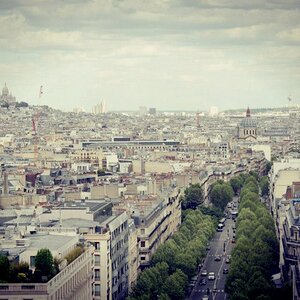
![[No title]](/data/xfmg/thumbnail/32/32926-ec27ecead8c80d803404500d8f888dbf.jpg?1619735754)
